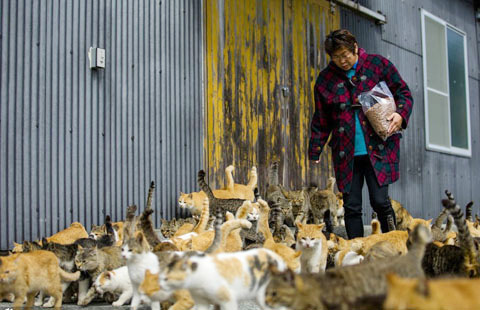Japan approves third nuclear plant for restart
Updated: 2015-05-20 11:14
(Agencies)
|
||||||||
 |
|
Members of the media and Tokyo Electric Power Co. (TEPCO) employees wearing protective suits and masks walk past storage tanks for radioactive water in the H4 area at the tsunami-crippled TEPCO Fukushima Daiichi nuclear power plant in Fukushima prefecture in this November 7, 2013 file photo. [Photo/Agencies] |
TOKYO - Japan's nuclear regulator signed off on the basic safety of a reactor at a third nuclear plant on Wednesday, as the country inches toward rebooting its atomic industry more than four years after the 2011 Fukushima disaster.
The decision will be a boost for operator Shikoku Electric Power Co, which relied on its sole Ikata nuclear power station in southwestern Japan for about 40 percent of its electricity output before the meltdowns at Fukushima led to the shutdown of all the country's reactors.
For the government of Prime Minister Shinzo Abe, resuming nuclear power, which provided about a third of Japan's electricity supply before Fukushima, is key to lifting the economy out of two decades of anaemic growth.
The country has switched to fossil fuels to compensate for the closure of reactors, pushing imports of liquefied natural gas to a record-high 7.78 trillion yen ($65 billion) in the financial year ended March 31.
The safety approval is still only one of three needed before the Nuclear Regulatory Authority (NRA) gives its final sign off. The consent of local authorities, which is seen as a formality, is also required, along with operational checks.
At a regular meeting on Wednesday, the NRA's commissioners signed off on a provisional assessment that the Ikata reactor meets new design standards introduced after Fukushima. The decision will be open to public comment for about a month before being formalized.
Located about 700 kms (660 miles) west-southwest of Tokyo on Shikoku island, the Ikata No. 3 reactor started operations in 1994 and has a capacity of 890 megawatts.
The future of the Ikata plant's two other reactors, each with capacity of 566 megawatts, is unclear. One is almost 40 years old, which is the lifetime limit for reactors in Japan without a special extension that will be costly to achieve.
Shikoku Electric hasn't applied for restarts of that reactor or the No. 2 unit, which began operations in 1982.
Two other nuclear plants operated by Kansai Electric Power
and Kyushu Electric Power have passed through the first stage of regulatory checks.
Operators also have to overcome legal hurdles. Anti-nuclear activists have stepped up petitioning the judiciary to block restarts, with a majority of the public opposed to atomic power.
Residents near the Ikata plant in December 2011 filed a lawsuit to mothball the station, but a decision will take time.

 Jetman duo zip across Dubai sky
Jetman duo zip across Dubai sky
 Creativity marks graduation photos
Creativity marks graduation photos
 Ten photos you don't wanna miss - May 20
Ten photos you don't wanna miss - May 20
 In photos: Cities in the clouds
In photos: Cities in the clouds
 Premier Li Keqiang welcomed by Brazilian president
Premier Li Keqiang welcomed by Brazilian president
 Weirdest towns in the world
Weirdest towns in the world
 Students from vocational schools also make big bucks
Students from vocational schools also make big bucks
 Ten photos you don't wanna miss - May 19
Ten photos you don't wanna miss - May 19
Most Viewed
Editor's Picks

|

|

|

|

|

|
Today's Top News
China, Brazil launch new era of economic relations
US should end its 'backyard' zero-sum game
Xiaomi debuts in US, Europe with online store
More than 450 scholars urge Japan to address history issues
Brazil embraces third wave of Chinese investment
Taoist teaches US official one or two things about feng shui
White House bans police from using certain military equipment
China eyes 'capacity exports' to sustain growth
US Weekly

|

|






